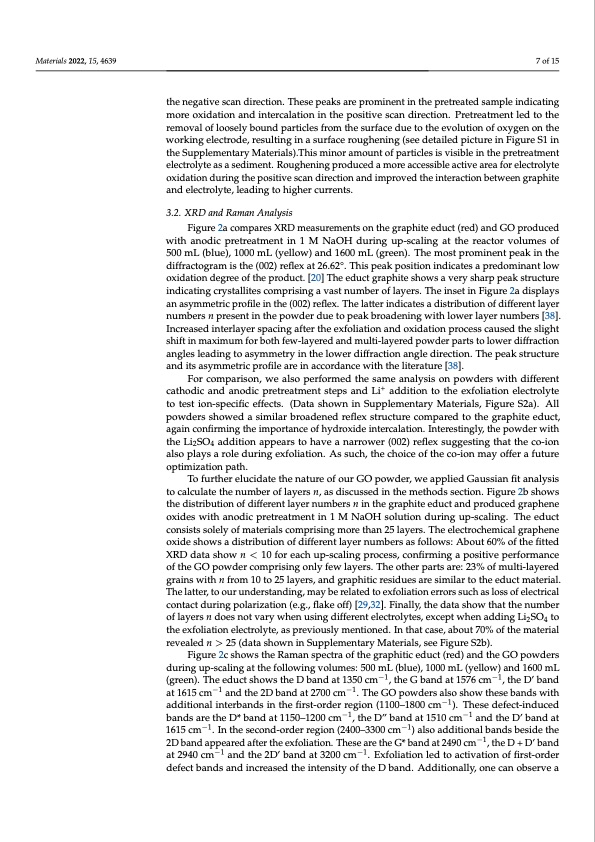PDF Publication Title:
Text from PDF Page: 007
Materials 2022, 15, 4639 7 of 15 the negative scan direction. These peaks are prominent in the pretreated sample indicating more oxidation and intercalation in the positive scan direction. Pretreatment led to the removal of loosely bound particles from the surface due to the evolution of oxygen on the working electrode, resulting in a surface roughening (see detailed picture in Figure S1 in the Supplementary Materials).This minor amount of particles is visible in the pretreatment electrolyte as a sediment. Roughening produced a more accessible active area for electrolyte oxidation during the positive scan direction and improved the interaction between graphite and electrolyte, leading to higher currents. 3.2. XRD and Raman Analysis Figure 2a compares XRD measurements on the graphite educt (red) and GO produced with anodic pretreatment in 1 M NaOH during up-scaling at the reactor volumes of 500 mL (blue), 1000 mL (yellow) and 1600 mL (green). The most prominent peak in the diffractogram is the (002) reflex at 26.62°. This peak position indicates a predominant low oxidation degree of the product. [20] The educt graphite shows a very sharp peak structure indicating crystallites comprising a vast number of layers. The inset in Figure 2a displays an asymmetric profile in the (002) reflex. The latter indicates a distribution of different layer numbers n present in the powder due to peak broadening with lower layer numbers [38]. Increased interlayer spacing after the exfoliation and oxidation process caused the slight shift in maximum for both few-layered and multi-layered powder parts to lower diffraction angles leading to asymmetry in the lower diffraction angle direction. The peak structure and its asymmetric profile are in accordance with the literature [38]. For comparison, we also performed the same analysis on powders with different cathodic and anodic pretreatment steps and Li+ addition to the exfoliation electrolyte to test ion-specific effects. (Data shown in Supplementary Materials, Figure S2a). All powders showed a similar broadened reflex structure compared to the graphite educt, again confirming the importance of hydroxide intercalation. Interestingly, the powder with the Li2SO4 addition appears to have a narrower (002) reflex suggesting that the co-ion also plays a role during exfoliation. As such, the choice of the co-ion may offer a future optimization path. To further elucidate the nature of our GO powder, we applied Gaussian fit analysis to calculate the number of layers n, as discussed in the methods section. Figure 2b shows the distribution of different layer numbers n in the graphite educt and produced graphene oxides with anodic pretreatment in 1 M NaOH solution during up-scaling. The educt consists solely of materials comprising more than 25 layers. The electrochemical graphene oxide shows a distribution of different layer numbers as follows: About 60% of the fitted XRD data show n < 10 for each up-scaling process, confirming a positive performance of the GO powder comprising only few layers. The other parts are: 23% of multi-layered grains with n from 10 to 25 layers, and graphitic residues are similar to the educt material. The latter, to our understanding, may be related to exfoliation errors such as loss of electrical contact during polarization (e.g., flake off) [29,32]. Finally, the data show that the number of layers n does not vary when using different electrolytes, except when adding Li2SO4 to the exfoliation electrolyte, as previously mentioned. In that case, about 70% of the material revealed n > 25 (data shown in Supplementary Materials, see Figure S2b). Figure 2c shows the Raman spectra of the graphitic educt (red) and the GO powders during up-scaling at the following volumes: 500 mL (blue), 1000 mL (yellow) and 1600 mL (green). The educt shows the D band at 1350 cm−1, the G band at 1576 cm−1, the D’ band at 1615 cm−1 and the 2D band at 2700 cm−1. The GO powders also show these bands with additional interbands in the first-order region (1100–1800 cm−1). These defect-induced bands are the D* band at 1150–1200 cm−1, the D” band at 1510 cm−1 and the D’ band at 1615 cm−1. In the second-order region (2400–3300 cm−1) also additional bands beside the 2D band appeared after the exfoliation. These are the G* band at 2490 cm−1, the D + D’ band at 2940 cm−1 and the 2D’ band at 3200 cm−1. Exfoliation led to activation of first-order defect bands and increased the intensity of the D band. Additionally, one can observe aPDF Image | Electrochemical Production Thermal Reduction Graphene Oxide

PDF Search Title:
Electrochemical Production Thermal Reduction Graphene OxideOriginal File Name Searched:
materials-15-04639.pdfDIY PDF Search: Google It | Yahoo | Bing
Salgenx Redox Flow Battery Technology: Power up your energy storage game with Salgenx Salt Water Battery. With its advanced technology, the flow battery provides reliable, scalable, and sustainable energy storage for utility-scale projects. Upgrade to a Salgenx flow battery today and take control of your energy future.
CONTACT TEL: 608-238-6001 Email: greg@infinityturbine.com (Standard Web Page)